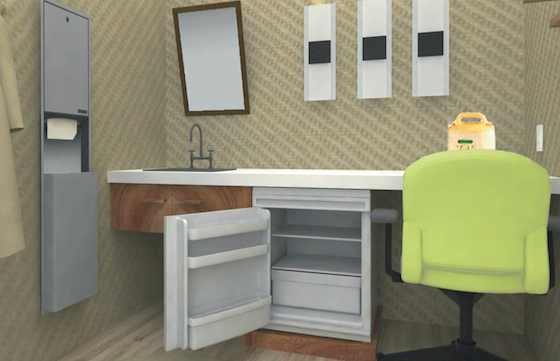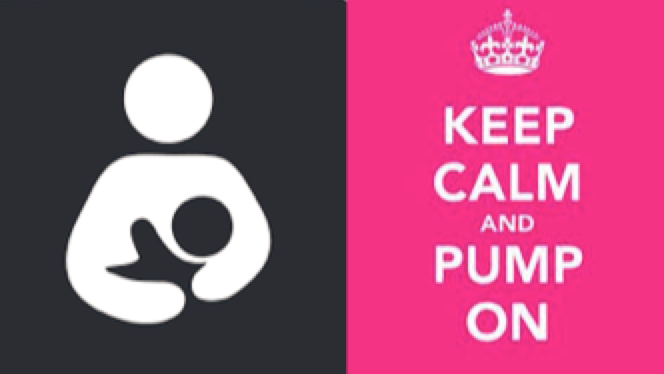Code Green Solutions


The influx of women in the workplace starting in the 1960s was partly attributable to the development of infant formula. Formula gives mothers of newborns added freedom to return to work after childbirth. However, in the last few decades, research findings overwhelmingly in favor of breast milk over formula have instigated a marked increase in the number of mothers choosing to nurse their children for the first year of life or longer. Fathers also benefit from healthier child development. The dramatic health benefits for infant and mother have influenced these mothers to dedicate long hours to pumping and storing breast milk when they are not with their babies. Many of these mothers return to work after just 6 to 12 weeks, and they need a dedicated place where they can comfortably and efficiently collect and store breast milk in the workplace.
 Some lactation rooms may also be used for wellness purposes that incorporate other functions in addition to lactation support. Design considerations outlined here are primarily designed around lactation needs, but other medical needs may also be well served by these facilities, such as light therapy, administering medication, meditation/stress relief, and sensory calming for migraine sufferers.
Some lactation rooms may also be used for wellness purposes that incorporate other functions in addition to lactation support. Design considerations outlined here are primarily designed around lactation needs, but other medical needs may also be well served by these facilities, such as light therapy, administering medication, meditation/stress relief, and sensory calming for migraine sufferers.
Mothers returning to the workplace after childbirth face challenges to express medically beneficial breastmilk while also reentering the workforce. Companies that provide lactation rooms in the workplace help these employees achieve both of these goals. Public facilities increasingly provide rooms for lactation and nursing due to growing demand. The design guidelines given here will yield a room layout that is easy to use and offers comfort and respect to mothers.
What are Wellness Rooms?
Several times a day, a nursing mother needs a quiet, enclosed room to collect expressed milk. She needs a calm restful environment for an efficient and safe pumping session.
A typical pumping session includes changing clothes, sitting at a work surface in front of a pump for 15 to 30 minutes, placing milk in storage bottles, washing bottles and pump parts and packing them away until the next pumping session, and redressing and returning to work. At the end of the session, the pumped milk must be stored in a refrigerator or cooler. In an eight-hour work day two or three pumping sessions are normal.
Other considerations for Lactation rooms, Mothers’ rooms, or Wellness rooms include the need for actual and perceived privacy. Working mothers experience a level of stress from newborn babies, transitioning work and family life. In addition, it is important to achieve auditory comfort in and around the space. Walls, doors, and locks must be substantial and provide a good sense of security. Particularly in public access facilities, such as airports, conference centers, libraries, museums, college campuses, shopping malls, and hotels, nursing mothers need a calm environment to breastfeed their babies and a secure space where their belongings, such as a stroller, can be accommodated.
Wellness rooms should provide, at a minimum, a lockable door; a work surface and chair; a small utility-type sink; storage for cleaning supplies and paper towels; adequate HVAC service, and well-placed electrical outlets. A refrigerator is desired in the workplace. Accessibility guidelines should be met for all the features of the room. The sample vignettes, while rudimentary, provide the space for pumping milk as well as breastfeeding.
Recommendations
Size
A minimum footprint of 7 feet by 7 feet is recommended as it allows for a 5-foot radius circle with a 24-inch deep counter. Other configurations such as 10 feet by 5 feet work well in offices and public facing facilities where more mothers are likely to be breastfeeding their babies.
Location
Each building should include a minimum of one Wellness room. As a rule of thumb, buildings with more than 100 women (or 200 employees, both male and female), at least one additional room or space is recommended. Where possible, these rooms should be proximate to other wellness amenities and bathroom facilities. Wellness rooms should be located in a safe area accessible to all. They should not be located in areas that would not be suitable for the preparation and storage of food.
Privacy
Install a user-operated lock with an indicator for privacy. The best locks include an indicator that displays an “occupied” message to discourage interruptions and still allow one hand operation for exiting the room in the case of emergency.
Sound Privacy
Walls should ideally reach up to the structure or install sound attenuation in walls to minimize echoes and sound transmission (i.e. minimum STC 45) over them into adjacent spaces. Carpeting or other sound-dampening materials to minimize echoes is recommended.
Chair
Provide a task chair suitable for a workstation. Fabric or material designed for easy cleaning or wiping is recommended. Seat, back, armrest, lumbar, tension, and height adjustments are preferable. Casters are also important to allow the user freedom of movement when hands are occupied with bottles of milk and pump parts. A more comfortable chair could also be placed in the room if mothers frequently use the room to breastfeed their babies.
Table/Counter
Provide a minimum 18-inch deep by 32-inch wide laminate or solid work surface at desk height for the pump and bottles to rest on in front of the chair. The surface should be easily cleaned or wiped down for the next user. Provide clear knee space beneath the counter. Electrical outlets above the work surface should be provided for the pump and accessories
Sink
Provide a sink and faucet combination deep enough to wash bottles and pump parts. Goose neck or kitchen type faucets are recommended. If possible, locate the sink adjacent to the work area and provide towel dispenser nearby.
Lighting and HVAC
Uniform ambient light is encouraged to provide a restful and soothing environment. Task lighting should be provided over the sink and the pump area. Room temperature should be maintained year-round at a comfortably warm level such as in a dressing room. A thermostat in the room could increase user control and thermal comfort.
Milk Storage
Install a midsize or compact refrigerator for milk storage in the workplace. Under-counter models help conserve floor space but should not take up the knee space beneath the work area. Refrigerators are not needed in public facing facilities where use is more transient. Rooms that are sized to accommodate more than one user may require a mid-sized or a large refrigerator, depending on frequency of use.
Accessories
Useful accessories in a Wellness room include a trash can, a paper towel dispenser, a coat rack or coat hooks, and a full-length mirror. Educational information for nursing mothers can be put on a bulletin board. Storage space for pumping supplies is recommended in office environments where users visit the room on a regular basis. Accessories should add to a calming environment and soothing wall color palette. If many mothers will be sharing the room, installing a scheduling system or communication board outside the door could facilitate efficient use of the room.
Workplace Wellness Room Sample Layout
Public Facility Wellness Room Sample Layout
Where do we go from here?
“With GSA’s standards leading in the area of women’s and infants’ health, we are proud to have an accessible wellness room outfitted with many of the amenities made available to the staff at our new regional office in Philadelphia,” says Sara Manzano-Diaz, Regional Administrator for the Mid-Atlantic Region of the General Services Administration.
Large government entities and corporations lead in creating these spaces. Many factors come into play, such as company culture, changing demographics and human resources support. Public access facilities will require even more forethought as there are many dynamic factors in addition to market conditions and operator requirements. The road is widening for designers and green building professionals.
“There is a strong literature supporting the health benefits of breastfeeding, both in terms of strengthening the maternal-infant bond and enhancing the child’s long-term development. Green building professionals can support breastfeeding through the creation of safe, hygienic wellness rooms for working mothers. These solutions represent how design is intricately linked with the public’s health,” Dr. Jennifer A. Pinto-Martin, Executive Director, Center for Public Health Initiatives, University of Pennsylvania School of Nursing and Perelman School of Medicine.
##
The content in this article is developed from the American Institute of Architects (AIA) Best Practice update by Liz York, FAIA, and Joyce Lee, FAIA. They would like to thank the Advisory Committee: Jane Kaufman, University of Pennsylvania School of Nursing, Amy Spangler of baby gooroo, Amanda Higgins, General Services Administration, Mara Baum of HOK, Melissa Walker, Hilton Hotels, Kristen Suzda, Wallace Roberts & Todd. Design assistance is provided by Yubei Huang and Tong Niu from PennDesign at the University of Pennsylvania.
If you have a well-designed Wellness room photo to share, please send to info@IndigoJLD.com
Please label with address, company name, and photo credit if appropriate.